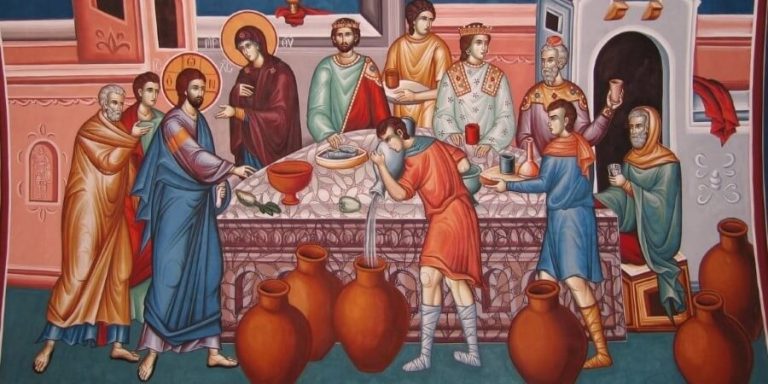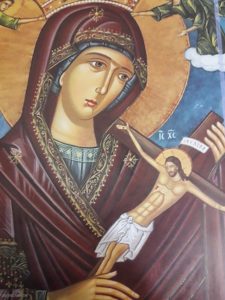Miracles in Orthodox Christianity

When the wine ran out, Jesus’ mother said to Him, “They have no more wine.” “Woman, why does this concern us?” Jesus replied. “My hour has not yet come.” His mother said to the servants, “Do whatever He tells you.”
Now six stone water jars had been set there for the Jewish rites of purification. Each could hold from twenty to thirty gallons. Jesus told the servants, “Fill the jars with water.” So they filled them to the brim. “Now draw some out,” He said, “and take it to the master of the banquet.” They did so. and the master of the banquet tasted the water that had been turned into wine. He did not know where it was from, but the servants who had drawn the water knew. John 2:8
Miracles in Orthodox Christianity are real and they happen with consistency and regularity throughout the centuries. The lives of the Saints of the Church are full of miracles and miracles are very much a part of the Orthodox Church.
“And they were greatly astonished, saying among themselves, ‘Who then can be saved?’ But Jesus looked at them and said, ‘with men it is impossible, but not with God, for with God all things are possible.” (St. Mark 10:23-27).
Holy Fire -Miracle that occurs every year in Jerusalem
Every Orthodox Holy Saturday( the day before Orthodox Easter) in Jerusalem’s Church of the Holy Sepulchre, thousands gather to witness a flame miraculously appearing in the tomb of Jesus Christ. Its is a potent symbol of the resurrection and the Church’s most important miracle. It has been happening annually for the past 1,200 years.
The ritual begins with the Greek Orthodox Patriarch of Jerusalem entering into the empty tomb of Christ within the church and chanting special prayers. Before the ritual a non-Orthodox Christian enters to examine the edicule (a small structure surrounding the tomb) to make sure no oil lamps, matches, or lighters have been left burning inside that the patriarch could use to light his candles…
Snakes in Kefalonia
Every year on or around August 6th, which is the feast of the Transfiguration, hundreds of Greek Orthodox pilgrims flock to witness a miracle in a tiny village on the western Greek island of Kefallonia.
Poisonous snakes appear around the bell tower of the church and begin crawling everywhere in the church, and particularly around an icon of the Virgin Mary. The snakes remain in the area of this church until August 15th which is the feast day of the Dormition of the Virgin Mary. The snakes disappear back into the wilderness of the area as soon as the Liturgy concludes on the 15th of August and are not seen again until the following year.
Myhrr Streaming From Icons and Their Shedding of Tears and Blood
From the first years of Christianity, unusual phenomena such as pouring of myhrr from the relics of Saints and the flowing of oily liquid from the icons of the saints (which has wonderful scents and healing properties) were observed. It is a liquid myhrr that God himself makes, and it contains in itself what is the basic element of all that exists. Many people wonder what these frescoes or icons are, whether they are just works of artistic value or a living window to God. In materialistic science, however, there is no answer to this question. I was blessed to have witnessed these phenomena many times. I would try to wipe off this liquid from the icons with my fingers and see it being produced again in front of my own eyes.
Holy Relics
As described in this video; Holy relics are a clear anticipation of the transfigured body after universal resurrection. The very fact that the bodies of the saints are kept in a state of incorruptibility is a foretaste, an anticipation of their future incorruptibility after resurrection and after their full theosis, deification. Relics consists of the physical remains of a saints or the personal effects and belongings of saints. Many miracles and miraculous healing occur to people that go to venerate the holy relics.
“But we all,” writes St. Paul to the Corinthians, “with unveiled face, beholding as in a mirror the glory of the Lord, are being transformed into the same image from glory to glory, just as by the Spirit of the Lord” (II Cor.3:18).
More Miracles in Orthodox Christianity ….
Miracle in Greece: An icon from which wilted lilies bloom!


On a small Greek island named Lipsos in the Church of St. John the Evangelist is an icon of the Most Holy Theotokos on which the Mother of God is represented with the crucifixion of Jesus Christ. It is also known as Panagia Harou, which comes from the Greek word Haros which signifies/means death. Every year on August 23, when this holy icon day is celebrated, believers gather here from all sides of the island to attend the flowering of wilted lilies; A miracle that has been repeated regularly every year on this day since 1943.
It all started during the years of occupation of the Greek islands. The Greek people were trying to save all that was worth before a foreign army that was trying to destroyed everything. The youngest daughter of a pious family, upon leaving the house, covered the icon of the Blessed Virgin Mary with a bouquet of six white lilies, praying for the quick freedom of her land. It was on the Feast day of the Annunciation. The lilies wilted, but on the same day on August 23, the flowers came to life again with the appearance of new small buds from the withered stems. Since then, every year the lilies that stand next to the icon bloom again on August 23.
It only did not happen the very year that the believer who first put lilies on the icon died. Residents in a special way celebrate this day as it is a special blessing of this manifestation of the will of God. People are especially honored that this is happening right on their island.
Lipsos is a small island with about 700 inhabitants. They say that each resident can have one church at a time. The most recent is the church of St. Nectarius from 1980. And the oldest churches date from the seventh and eighth centuries. There is also the Church of the Assumption of the Blessed Virgin Mary, which houses the Holy Relics of martyrs who were killed by the Turks. Then the Church of Our Lady of Causelio whose age has yet to be determined. Two churches on two hills above the harbor are dedicated to St. Nicholas. Also there us the church of St. Elijah and dozen of other churches in a row
